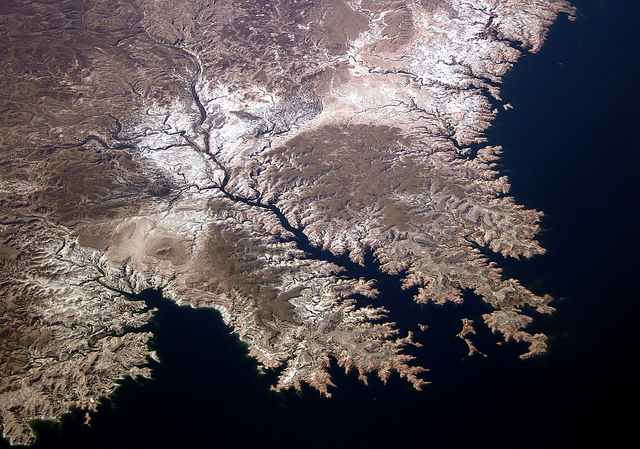Splatter Paint Science: Jackson Pollock and Fluid Dynamics
This article was adapted for middle school students from an original article called “The Cutting Edge Physics of Jackson Pollock” by Lisa Grossman (Wired Magazine. July 2011). You can read the original article here: https://www.wired.com/2011/07/pollock-physics/ For more about Jackson Pollock take a look at the Khan Academy Video: "Why is That Important: Looking at Jackson Pollock."
 |
| Untitled. 1948-1949. Jackson Pollock. |
Jackson Pollock was an artist who was famous for his drip paintings. Scientists now think that he was using art to explore an area of science called fluid dynamics years before scientists even thought to study it.
"His particular painting technique essentially lets physics be a player in the creative process," said physicist Andrzej Herczynski of Boston College, coauthor of a new paper in Physics Today that analyzes the physics in Pollock's art. "To the degree that he lets physics take a role in the painting process, he is inviting physics to be a coauthor of his pieces."
 |
| You can see fractals in the coastline of Britain from space. |
But now, art historians and physicists argue that these wiggly lines are not random. Some people think that the splatter lines Pollock made look like something called fractal geometry. Fractal geometry is the study of patterns in nature. You can see examples of fractal geometry in the jagged outline of frost, clouds, and coastlines.
An art historian named Claude Cernuschi is working with a mathematician caned Lakshminarayanan Mahadevan. They are using the science of physics to think about at Pollock's paintings in a new way. They have created a math equation to show how Pollock spread his paints.
Art and the Science of How Solutions Move: Fluid Dynamics
The team looked at the painting Untitled 1948-49, which features wiggling lines and curlicues of red paint. The loops we can see in the painting were made by a property of fluid called coiling. Coiling is a scientific term that describes what thick fluids like paint do when they fold back on themselves like coils of rope.

Coiling: Pouring Honey or Paint
If you have ever poured honey on toast you have seen coiling. It describes the way thick liquids make swirls. Recent studies have shown that the patterns fluids form as they fall are different for thick fluids and thin fluids. The patterns are different when liquids move quickly or slowly. Viscosity is the word for the thickness or thinness of a fluid. Viscous liquids fall in straight lines when moving quickly, but form loops, squiggles, and figure eights when poured slowly. You can see coiling in this video of honey falling on a conveyor belt.
Thick Paint and Thin Paint Make Different Types of Drips and Swirls
Pollock was famous for researching and using different kinds of paints. He mixed his paints with different solutions to make them thicker or thinner, scientists call this changing their viscosity.
Instead of using a brush to apply the paint, he lifted paint with a stick and let it dribble and drip onto the canvas in continuous streams. By moving his arm at different speeds and using paints of different thicknesses, he could control how much coiling showed up in the final painting.
What was the Artist Thinking About?
If you have ever poured honey on toast you have seen coiling. It describes the way thick liquids make swirls. Recent studies have shown that the patterns fluids form as they fall are different for thick fluids and thin fluids. The patterns are different when liquids move quickly or slowly. Viscosity is the word for the thickness or thinness of a fluid. Viscous liquids fall in straight lines when moving quickly, but form loops, squiggles, and figure eights when poured slowly. You can see coiling in this video of honey falling on a conveyor belt.
Thick Paint and Thin Paint Make Different Types of Drips and Swirls
Pollock was famous for researching and using different kinds of paints. He mixed his paints with different solutions to make them thicker or thinner, scientists call this changing their viscosity.
Instead of using a brush to apply the paint, he lifted paint with a stick and let it dribble and drip onto the canvas in continuous streams. By moving his arm at different speeds and using paints of different thicknesses, he could control how much coiling showed up in the final painting.
What was the Artist Thinking About?
Do you think Pollock was thinking about fluid dynamics when he made his paintings? The scientists are not sure. "I think if you told Pollock, 'You're exploring physics,' he would think you were crazy," Herczynski said. "He did it intuitively. His interest was not so much the physics of the process, it was to achieve a certain aesthetic effect. But the two are bound together. You can't separate them. You're inviting physics to be a part of it."
Citation: "Painting with drops, jets and sheets." Andrzej Herczynski, Claude Cernuschi, and L. Mahadevan. Physics Today, Vol. 64, Issue 6. June 2011.
Vocabulary
For more thoughts about physics and art, in this case, ballet, check out this Ted.ed video called "The Physics of the Hardest Move in Ballet."
Citation: "Painting with drops, jets and sheets." Andrzej Herczynski, Claude Cernuschi, and L. Mahadevan. Physics Today, Vol. 64, Issue 6. June 2011.
Vocabulary
- Fluid dynamics (PBS video: Fluids in Motion 10 minutes)
- Technique
- Physicist
- Physics
- Haphazard
- Random
- Fractal geometry
- Equation
- Curlicues
- Property of fluid
- Coiling
- Solutions
- Continuous
- Aesthetic
For more thoughts about physics and art, in this case, ballet, check out this Ted.ed video called "The Physics of the Hardest Move in Ballet."

Comments
Post a Comment